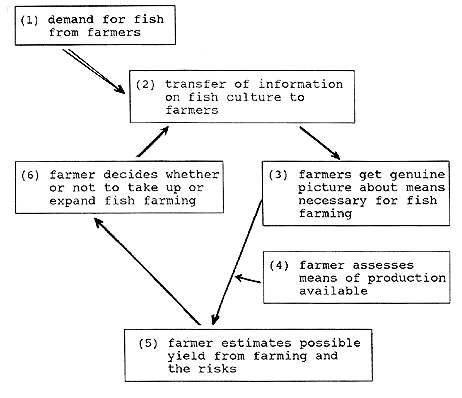A general model on the adoption of innovations was used to understand the adoption of fish farming as a new activity. The model consists of three sets of variables:
Background variables: These form the socio-cultural and economic environment where a new activity will take place.
Intervening variables: These are the necessary resources which a person should dispose of if he/she wants to start fish farming. Examples are land, water, labour and fish feed. The amount of resources available determine the possible types of fish farming which can be practised.
Independent variables: These variables explain the process of adoption of an innovation in a certain socio-economic setting for a person who has the means.
The likely sequence of the adoption process is as follows:
The farmer must feel the need for fish; if this prerequisite is not met the process will stop since the information he/she might receive on this subject will not be considered to be of any interest;
Potential farmers must be told about the possibility of fish farming and given information about it: this can include actually seeing a fish pond;
The farmer will form ideas about the means necessary for fish farming and;
Compare it with the resources available to him/her (intervening variables);
The farmer tries to estimate the yield and the risks incidental to it;
The farmer takes a decision whether or not this new activity is interesting for him/her.
He/she might look for more detailed information and go through this process several times before the final decision is taken.
Through extension, the independent variables can be influenced. The transfer of information is one of the most important links in this whole process.
Figure 1: Diagram of the adoption of innovation process

Within the context of the pilot project, the sets of variables and the different steps of the adoption process were tested for their relative importance to the aquaculture development process.
Information on the background, intervening and independent variables was initially collected from secondary data. Investigations, surveys and other statistical background collected and compiled by Government Authorities, Study Bureau and Development Agencies were reviewed. The studies gave information on socio-economic and cultural conditions, nutritional status, climate, topography, water supply, agricultural farming systems, credit and extension.
Additional information was obtained from key informants through discussion either individually or through groups.
Interviews with fish farmers (active and potential) provided additional information on reasons for starting/considering fish farming, problems encountered/envisaged, etc. Observations during cropping of one pond together with interviews on intermediate harvesting, inputs and expenditures provided information for estimates on yields and profitability.